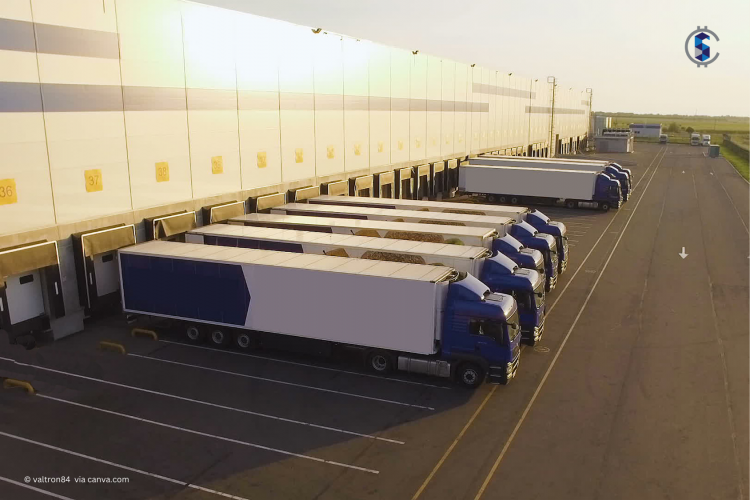
In the ever-evolving landscape of real estate investments, one asset class that has been gaining significant traction is logistics real estate. Logistics properties play a critical role in facilitating the movement and storage of goods, making them an integral part of the global supply chain. In this comprehensive guide, we will delve into the world of logistics real estate, its investment fundamentals, various property types, key considerations for investors, investment strategies, and the future trends that are shaping this dynamic sector.
Understanding What is Logistics Real Estate
Logistics real estate, also known as industrial real estate, is a distinct asset class comprising a range of properties essential for the efficient flow of goods. These properties are strategically positioned to serve as key nodes in the supply chain, ensuring that products move swiftly from manufacturers to retailers and ultimately into the hands of consumers.
Among the primary property types within logistics real estate are warehouses, distribution centres, and fulfilment centres.
The Growth of E-commerce and Its Impact on Logistics
The exponential growth of e-commerce has left an indelible mark on logistics real estate. E-commerce companies require strategically located logistics facilities to meet the escalating demand for fast and efficient deliveries.
The rise of e-commerce has not only fueled the need for more logistics real estate but has also shifted the requirements for these properties. Consumers now expect rapid deliveries and hassle-free returns, demanding a robust and efficient logistics infrastructure.
Investment Fundamentals of Logistics Real Estate
Now that you have gained insight into the logistics real estate sector, it is crucial to understand the core investment fundamentals that make this asset class a lucrative consideration.
Drivers of Investment in Logistics Real Estate
Several factors have contributed to the growing appeal of logistics real estate among investors. Foremost among these is the unprecedented growth of e-commerce. The steady and consistent rise of online shopping has created a surge in demand for logistics properties to meet the rapid increase in order fulfilment requirements. Furthermore, logistics real estate has historically demonstrated resilience, even during economic downturns. It continues to be a preferred asset class, offering stability in uncertain times.
Advantages and Benefits of Investing in Logistics Real Estate
Investing in logistics real estate provides investors with an array of advantages and benefits. One of the primary benefits is the prospect of stable income, attributed to long-term leases signed with reliable tenants. These tenants are often backed by large corporations, ensuring a consistent and stable income stream.
Additionally, the strategic location of logistics properties can lead to capital appreciation, adding to the investment’s overall returns. Equally important is the sector’s role as an economic hedge. Logistics real estate has proven to be a hedge against economic volatility. Even during economic downturns, the demand for efficient supply chain solutions remains robust.
Types of Logistics Real Estate
Understanding the different types of logistics real estate is crucial for investors aiming to diversify their portfolios and leverage the dynamic nature of this sector. Each type of property plays a distinct role in the supply chain and comes with its own set of operational requirements and investment considerations.
1. Warehouses
Typically used for storage and inventory management, warehouses are essential for businesses managing large volumes of products. They are strategically designed to provide efficient storage and retrieval, often using advanced logistics technology.
2. Distribution Centres
Distribution centres act as intermediaries within the supply chain. Positioned in key geographical locations, they streamline the distribution process by consolidating, sorting, and redistributing products to various destinations. This strategic positioning is pivotal in minimising transportation costs and reducing delivery times.
3. Fulfilment Centres
Fulfilment centres have emerged as a key focus within logistics real estate, largely due to the surging growth of e-commerce. These centres are central to the efficient functioning of e-commerce businesses. They are responsible for receiving orders, picking items from shelves, packing orders, and ensuring they are shipped swiftly to customers.
These centres stand apart due to their specialised nature. They are often equipped with advanced technology, such as robotics and automated sorting systems, to expedite the order fulfilment process. They are strategically positioned to ensure speedy deliveries to consumers, meeting the high expectations of the e-commerce industry.
4. Cold Storage Facilities
Cold storage facilities are essential within logistics real estate, serving the critical role of preserving temperature-sensitive products. Cold storage facilities primarily cater to industries that deal with perishable goods, such as the food and pharmaceutical sectors. These facilities are equipped to maintain precise temperature and humidity levels to ensure product quality and safety.
However, investing in cold storage facilities is not without its unique set of challenges. These challenges include high operating costs, stringent regulatory compliance, and the need for specialised infrastructure to maintain consistent temperatures.
Key Considerations for Investors
Successful investment in logistics real estate hinges on the following factors:
Location, Location, Location
Location is one of the most critical factors in logistics real estate investment. Properties in close proximity to transportation hubs, such as major airports, ports, and highways, are highly desirable due to their direct access to transportation networks. These locations minimise transportation costs and enhance supply chain efficiency.
The proximity of logistics properties to densely populated consumer markets is another key consideration. This not only reduces transportation costs but also ensures quicker delivery times, aligning with the demands of e-commerce and customer expectations.
Tenant Quality and Lease Terms
The quality of tenants and the length of lease terms are paramount to the success of logistics real estate investments. Having creditworthy tenants significantly reduces the risk of rent default and ensures a steady income stream.
Furthermore, long-term leases, typically spanning 5 to 15 years, offer greater stability. These extended agreements reduce the risk of property vacancies and offer a predictable cash flow, corresponding with the strategic plans often associated with logistics properties.
Due Diligence and Risk Mitigation
Before investing in logistics real estate, thorough due diligence is essential. This process should include an in-depth property inspection to assess the physical condition of the property. This includes evaluating the structure, roofing, HVAC systems, and other components. Identifying necessary maintenance or repairs is pivotal in mitigating potential issues and expenses.
In addition, environmental assessments are an integral part of due diligence, particularly for properties with a history of industrial or manufacturing use. These assessments identify potential environmental risks and liabilities, ensuring investors are aware of any contamination or regulatory compliance concerns.
Investment Strategies in Logistics Real Estate
To maximise returns in logistics real estate, investors can explore various investment strategies, including:
Direct Ownership vs. Indirect Ownership
Investors have choices when it comes to participating in logistics real estate.
- Direct Ownership – This approach involves purchasing and managing individual logistics properties. Direct ownership provides investors with full control over their investments, enabling them to make property-specific decisions.
- Indirect Ownership – Indirect ownership options include real estate investment trusts (REITs) and investment funds. REITs allow investors to gain exposure to logistics real estate without directly owning and managing properties. Investment funds, on the other hand, pool resources from multiple investors to collectively invest in logistics properties. These indirect ownership options are suitable for investors seeking diversified exposure and professional management.
Diversification within Logistics Real Estate
Diversification can enhance the performance of logistics real estate investments.
- Sub-Sector Diversification – Investors can diversify within logistics real estate by exploring various sub-sectors. This includes considering investments in cold storage, fulfilment centres, and more. Diversification allows investors to spread risk and capitalise on different market dynamics.
- Geographical Diversification – Geographical diversification involves spreading investments across different regions or markets. Diversifying across regions can mitigate the risk associated with market-specific economic fluctuations.
Challenges in Logistics Real Estate Investment
Investors should be aware of potential challenges within the logistics real estate sector.
- Rising Competition – The increasing interest in logistics real estate has driven competition among investors, potentially leading to higher property prices. It’s essential to conduct thorough market research and due diligence to identify attractive investment opportunities.
- Regulatory Hurdles – Navigating zoning and permitting requirements can be complex in the logistics real estate sector. Investors should be prepared to address regulatory challenges specific to the regions where they intend to invest.
Future Trends in Logistics Real Estate Investment
Staying informed about future trends and opportunities is critical for making sound investment decisions in logistics real estate.
- Automation – Automation technologies are rapidly shaping the future of logistics real estate. The implementation of robotics, artificial intelligence, and automation systems can enhance efficiency and reduce labour costs.
- Sustainability – Sustainability is gaining prominence within logistics real estate. Eco-friendly design and operational practices can minimise the environmental footprint of logistics properties, meeting the growing demand for sustainable practices.
- Last-Mile Solutions – As the demand for same-day and next-day deliveries increases, innovative last-mile delivery solutions are becoming crucial within logistics real estate. Investors should keep an eye on developments in this area, as they can significantly impact the value and demand for logistics properties.
What’s Ahead?
Logistics real estate is a compelling asset class that offers investors stability, long-term income, and resilience, making it an attractive choice within the real estate investment landscape. By understanding the fundamentals, property types, key considerations, and investment strategies, investors can confidently navigate this dynamic asset class.
As logistics real estate continues to evolve, it presents new challenges and opportunities. Staying informed about these developments and trends is essential for making informed investment decisions. The world of logistics real estate is teeming with potential, and for investors who are prepared and strategic, it can be a valuable addition to their investment portfolio. Explore real estate property types with SafeRE and consider how logistics real estate can enhance your investment portfolio and contribute to your long-term financial goals.
Interested in Logistics Investments? Explore more opportunities with SafeRE
SafeRE has created a revolution in providing direct access to quality real estate investments by reducing fees and offering a seamless and transparent investment process. SafeRE’s real estate investment platform provides access for investors to funds that exhibit steady performance over the years. SafeRE constantly introduces more efficient ways to build your wealth through a selected range of quality investments. For more information on investment opportunities, feel free to reach out to us or directly access your account on the SafeRE platform.
Disclaimer: This is not an advertisement making an offer or calling attention to an offer or intended offer. The information contained herein is for informational purposes only and has not been independently verified to ensure its accuracy and fairness. Nothing in this content material should be relied upon as a representation or warranty as to the future. In considering any investment or other performance contained herein, investors should bear in mind that past performance is no guarantee of future results and should consult their respective advisors.
Neither this article nor anything contained herein shall form the basis of any contract or commitment whatsoever should not form the basis of any investment decision and should not be considered as advice or recommendation by SafeRE, its affiliates, representatives, directors, managers officers, employees, agents, to acquire any investment products.
This article is confidential and may not be copied, distributed, or reproduced in any form for any purposes without prior consent provided by SafeRE.



